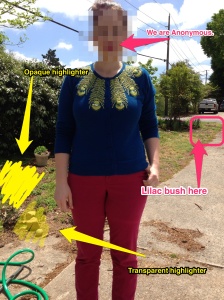
Stand Your Ground v. Castle Doctrine-Where Does Arkansas Fall on the Spectrum?
Preliminary note 1: I’ve chosen to use male pronouns throughout. That’s not because women don’t use these doctrines, because they definitely do; however, the majority of cases involve men.
Preliminary note 2: If you know me personally, you are probably expecting me to come down harshly against SYG. That’s not necessarily the case, as we will discuss at the end. Trust me, that’s painful to say, but for me, it really comes down to application, as the problems associated with the law itself are inherent in every type self-defense law.
Preliminary note 3: While I support some gun regulations, I don’t have a beef with responsible gun ownership (shocking, I know!). I’m actually a pretty good shot.
Ok, enough, enough.
So-called “Stand Your Ground” laws (hereinafter “SYG”) and “Castle doctrine” laws have made lots of news lately (as usual, thanks to Florida!).

One of our upcoming Attorney General candidates has even made introducing a Stand Your Ground law in his first legislative package a campaign priority. With all the recent hullabaloo, I thought it might be helpful to discuss where Arkansas actually falls on this issue. We’ll use Arkansas statutes and case law to examine the current state of law.
What’s the Difference?
The real legal questions here are: 1)When, 2) where, and, 3) if someone has a duty to retreat before using deadly force in self-defense. It’s important to know that just because a state has SYG or a “Castle doctrine,” that doesn’t necessarily mean its the same from state to state. It’s better to think of this as a bag of options, with states picking and choosing which options to apply.
Some states have explicit statutes, some states use case law, most use both.
That being said, there are typical definitions for each.
Here’s what the spectrum looks like:
Duty to Retreat if at all possible, no matter the location.
Duty to Retreat, if at all possible, but only if the initial aggressor shares the dwelling where the attack is happening.
No duty to retreat, if altercation is happening in the defendant’s home (his “castle” and sometimes this includes defendant’s vehicle). 46 states currently have at least this definition.
No duty to retreat, if altercation is happening in the defendant’s home or the area around his home (called the “curtilage”). This is Arkansas, currently and a significant minority rule. The retreat rule has always been the minority rule in the U.S.
This is an example of how media confuses SYG with Castle doctrine:

Notice they are in the curtilage of this couple’s home.
No duty to retreat, if defendant is any place he is lawfully entitled to be (this is the typical definition of SYG). This is the majority rule and it has been the majority since even before the recent newsworthy trials came up.
In every definition, the use of deadly force in self-defense must be justifiable, which generally means that the defendant reasonably believed either his life was in danger or that he was in danger of great bodily harm (self-defense usually provides that you meet “force with force,” i.e., you can’t use deadly force when someone is flicking rubberbands at you). Some states also allow the use of deadly force to prevent the sexual assault of yourself or someone else.
Justification: Immunity or Defense?
Using force in self-defense is known as “justification.” But some states define justification as an “immunity” and some define it as a “defense.”
Immunity bars suit, charges, detention and arrest. A defense allows the state to bring criminal charges or a private person to bring a civil complaint, but the defendant may present mitigating circumstances that ultimately relieve him of responsibility or culpability.
In Arkansas, force used in self-defense falls under the category of “defense.” ACA 5-6-202.
The State has the burden of negating defense of justification in prosecution for homicide.
Arkansas Statutory Law
Who are we talking about?
First, we are talking overall about ordinary citizens. There are other standards that apply to police officers, etc. That’s a whole different body of law (as I’ve been learning on a case I’ve been working on for the past couple of years).
As discussed above, we are generally discussing defending your own person, but sometimes you can also be justified in defending someone else and sometimes you can even be justified in defending property, not just a person.
Non-deadly force:
Defense of a person.
ACA 5-2-606 covers the use of regular (non-deadly) physical force in defense of a person.
In Arkansas, a person is justified in using physical force upon another person to defend himself or herself or a third person from what the person reasonably believes to be the use or imminent use of unlawful physical force by that other person, and the person may use a degree of force that he or she reasonably believes to be necessary.
But note: You aren’t justified to use physical force to defend yourself if
1) you provoke the other person into using unlawful physical force and your purpose is to cause them physical injury or death; or
2) you are the initial aggressor, unless
a) you withdraw from the encounter and that withdrawal is effectively communicated,
b) the other person continues or threatens to continue the use of unlawful physical force; or
c) the physical force involved is the product of a combat by agreement not authorized by law. (I really hope this is about dueling!)
What about a premises?
A person in lawful possession or control of premises or a vehicle is justified in using nondeadly physical force upon another person when and to the extent that the person reasonably believes the use of nondeadly physical force is necessary to prevent or terminate the commission or attempted commission of a criminal trespass by the other person in or upon the premises or vehicle. ACA 5-2-608.
Deadly force:
Defense of a person.
ACA 5-2-607 covers the use of deadly physical force in defense of a person.
In Arkansas, you can use deadly force if you reasonably believe that the other person is:
1) Committing or about to commit a felony involving force or violence;
2) Using or about to use unlawful deadly physical force; or
3) Imminently endangering the person’s life or imminently about to victimize the person as described in § 9-15-103 from the continuation of a pattern of domestic abuse.
When do you have a duty to retreat?
You cannot use deadly force if you know that by retreating (i.e., leaving, fleeing, etc.) you can avoid the necessity of using deadly physical force with complete safety.
The duty to retreat DOES NOT APPLY if you are in your own dwelling or on the curtilage surrounding your dwelling and you were not the original aggressor. That includes when the dwelling is also shared by the victim. See

What about personal property?
You cannot use deadly force to protect only property when the other person is claiming it is rightfully theirs (even if they are incorrect). If their is force, burglary, etc. to go along with the attempt on personal property, those situations are already covered.
What about real property?
You can use deadly physical force to protect real property if
1) Use of deadly physical force is authorized by the stuff I already talked about; or
2) You reasonably believe the use of deadly physical force is necessary to prevent the commission of arson or burglary by a trespasser. ACA 5-2-608.
Presumption of justification in your own dwelling:
5-2-620 also outlines a presumption that any force or means used in your own dwelling was exercised in a lawful and necessary manner, unless the presumption is overcome by clear and convincing evidence to the contrary. That’s not just a presumption, that’s a strong presumption, but in criminal cases it doesn’t have any effect, because the State already has the burden to prove its case beyond a reasonable doubt.
Other Statutes:
There are additional statutes which cover the use of physical force in specific situations (protecting unborn child, etc.) that I haven’t covered. Those are all in the same chapter and
Use of Deadly Force Application in Arkansas Case Law
Here a two example cases demonstrating fact patterns where deadly force was not found to be reasonable, even when the offenses occurred on the defendants’ properties.
Sipe v. State
Our most recent reported case dealing with the duty to retreat is Sipe v. State of Arkansas, 2012 Ark. App. 261 (CA CR 11-677, April 18, 2012). Robert Sipe said that he awoke to the sound of his four-wheeler ATV being started and the engine revving. Sipe said that he looked out of his window and saw a man on his ATV. Sipe then got dressed, grabbed his handgun, removed the barricade from his front door, and went out on his porch to investigate. Sipe testified that he saw a man riding his ATV and when the man started coming toward him, Sipe fired a warning shot. When the man kept coming, Sipe shot him. Sipe also testified that the man pointed something at him, but that he did not know what the man was pointing. After shooting him, Sipe went to the victim and discovered that it was Brian Lumen, a childhood friend. Sipe placed two blankets on top of Lumen’s body and waited for police to arrive.
According to Sipe, he and Lumen had been estranged for the last five years due to Lumen’s “destructive behavior.” Appellant claimed that when he had tried to rekindle his friendship with Lumen in 2009, he had to ask Lumen to leave his property because Lumen was “on drugs.” Appellant testified that after that incident, things “began happening” at his house, including his dog’s inexplicable death, his door being kicked in with items stolen (including the ATV key), tractor tires being slashed, etc.
Sipe testified that he began barricading his front door and argued that he was justified in shooting the victim because he feared for his life.
The Arkansas State Medical Examiner testified that the victim was shot in the back—“left flank.”
Defendant Sipe was convicted of manslaughter in Garland County for shooting Brian Luman and given 20 years imprisonment.
Given the site of the injury, it was reasonable to assume the victim was fleeing and was not endangering the life of Sipe, but Sipe claimed he was justified in defending his property as well. Even assuming that the appellate court addressed that issue, which it didn’t because it wasn’t properly raised below, Sipe would not have been justified in defending his ATV with deadly force because none of the elements of 5-2-607 were met.
What if Arkansas had SYG? Most SYG statutes do not apply to protecting property when there is no reasonable belief of danger to the person, so the outcome would be the same.
On June 1, 2000, Pete’s estranged wife, Lauren , her brother, Ricky Jasay, and two other friends, gathered at Anderson’s house to drink and shoot pool. Lauren passed out early in the evening so Anderson put her to bed in his bedroom. Their relationship, however, was not romantic. Later that evening, Pete started spinning his pickup truck around in the field next to Anderson’s house. It was then that Anderson went inside the house and brought out a shotgun. One witness heard him say, “[w]e got three options. I’ve got this gun and I got this knife or we can compromise.”
Pete drove away, heading toward his father’s house; but, later he was seen running down the road because he had run out of gas. Anderson offered to give him some gas, so the two men went to Anderson’s shed and returned with a plastic jug. At that point, Pete started asking Ricky if his estranged wife, Lauren, was inside appellant’s trailer. When Ricky would not respond, Anderson intervened and told Pete that Ricky did not have to tell him anything. According to one witness, Pete jumped up, shook his finger in appellant’s face and shouted: “Look, Randy, this ain’t concerning you. It’s between me and Rick. I just want to know if Lauren is inside. I want to talk to her.”
Anderson testified as follows: Pete’s argument with Ricky resumed after he told Anderson to stay out of his business. Pete threatened to kill “every MF in here if I have to,” and he tried to get into the house to see Lauren. Anderson barred him from getting into the house because he did not know what Pete would do to Lauren if he found her passed out on appellant’s bed. Pete then called Anderson out to the yard to fight. Anderson picked up his shotgun and followed Pete out to the driveway. When Pete turned suddenly and rushed him, Anderson pulled the trigger. He could not remember firing the second shot, but he did remember moving the body because he was afraid Pete’s father would see the body and kill him.
Barbara Snow testified that she and her boyfriend, Dale Adams, were in bed on the evening of the shooting incident when she received a call from Anderson. Barbara rode with Dale to Anderson’s trailer. When they pulled up, she saw a large puddle of blood near the driveway. She recounted several statements that Anderson made that night: “He said that he shot him in the, I mean, in the chest one time. And he said he was moaning and he said, ‘I finished him off. I shot him in the head.’ ” Barbara also testified to hearing the following conversation between Anderson and her boyfriend, Dale: “Anderson asked Dale, he said, ‘What to you think I’ll get for this?’ Dale said, ‘Man, twenty years or better.’ He said, ‘I can do twenty.’ … [H]e picked up a knife and he said, ‘I can say he was coming after me and he, you know, it was self-defense.’ ”
According to the medical examiner, Pete would have lived three or four minutes had he not been shot the second time.
The jury did not find Anderson’s testimony credible and convicted him of capital murder.
Result under SYG?: Same, because the use of deadly force was not reasonable.
Is Stand Your Ground Bad Law?

Well, obviously not. That’s not the case under SYG either. This is a really a disagreement with a jury’s finding of reasonable apprehension of bodily harm.
I Don’t Think it’s Inherently Bad
Hang with me, liberals.
Justice Oliver Wendall Holmes, Jr. said in Brown v. US (256 U.S. 335, 1921) that “detached reflection cannot be demanded in the presence of an uplifted knife.” Realistically speaking, if someone is actually threatening your life and you are able to fight back, you aren’t going to run through an analysis of whether or not you can flee with complete safety. You definitely aren’t going to run through a legal analysis of your options.
Complete safety is a pretty high hurdle to meet. I have a hard time seeing a jury convicting someone, if deadly force was threatened, because they didn’t retreat. It’s much more likely someone would be convicted because deadly force wasn’t appropriate to begin with (as we saw in the two cases above).
Some examples cited by media claiming the results would be different under the different self-defense retreat rules are just false.
Example 1: The garbage dispute
The shooting victim claims he knocked on the shooter’s door because the shooter had reported his illegal conduct to the authorities. An angry confrontation ensued and the shooter closed the door. Apparently the victim continued pounding on the door so the shooter opened it and shot him.
If true, the shooting was equally illegal under the retreat rule or Stand Your Ground laws. Under all of them if someone breaks down your door you may shoot. Under none of them can you open the door and shoot someone who angrily pounds on your beyond which you a safe.
Note that there is also complete agreement under each rule if we assume the shooter’s story is correct. If you open the door to talk to someone who then tries to force his way in you may shoot unless it is clear that he cannot get in (e.g., a 110 pound woman tries to force her way into the home of a man who is 6′ tall and weighs 185 lbs.)
Example 2: The prostitute
Her story is that her elderly client pulled a gun declaring that he was going to kill her and then himself. She wrests the gun away from him and then shoots him rather than fleeing. Even under the retreat rule one is only required to retreat if ths is clearly possible. Under these circumstances she was privileged to shoot rather than run away taking the chance that this homicidally desperate man can jump on her and get the gun.
See also People v. Riddle, a case from a retreat rule state [47 Mich. 116, 649 N.W.2d 30, 2002]:
[this case upholds the retreat rule in theory but severely limits it. Facts showed that defendant was not attacked at all and court upholds conviction.]
Example 3: The cabbie
His story is that after he got his passenger out of the car, the passenger pulled a knife. Obviously the cabbie was not required to partially turn away and try to get in his cab exposing his side and back to a stab wound. Nor need he have done that even if the passenger had not had a knife. Retreat is required only if it can be accomplished in complete safety.
Arguments Against Stand Your Ground Don’t Always Hold Up, Although There Are Some Concerns in its Application
1) SYG is backwards law and only hick states use it

As we discussed above, the duty to retreat in public spaces has always been the minority. SYG is not limited to “hick” states and it’s not new. The media has trouble discerning between states where SYG is codified and those where it is common law, so graphical representations are often distorted.
2) SYG leads to a disproportionate amount of injury to minorities.
Economist at Georgia State found a significant increase in homicide and injury to more white males than minority males in states with SYG laws. But, there does appear to be a higher prosecution rate against minorities (no surprise there) in cases where self-defense operates as an immunity. This applies to all types of rules, but obviously SYG provides more opportunities for prosecution to arise.
3) SYG has a disproportionate racial impact

When Caucasians use the SYG against black attackers, they are more successful than when black attackers use the defense against white attackers, 17% to 1% respectively (also, no surprise there).
This is where the problem lies. I really don’t think it’s the law itself that’s an issue (although you may disagree); for me the problem lies in its application. But, that is true of a lot of laws and it doesn’t mean that we strike them down. It’s an issue that needs to be addressed throughout the entire criminal justice system.
Here is an ad put out by a conservative group, playing on fears of racial minorities, in order to make fun of liberal opponents of SYG laws:

3) SYG leads to higher rates of murder/crime.
Maybe yes, maybe no…studies on this actually show crime decreasing in some states with SYG (for instance, Florida), but other studies show an increase in murder rates.
4) SYG leads to “shooting first”

This is true of all kinds of self-defense.

Again, this is true of every type of self-defense law.
5) If the other witness is dead, how do we know it was self-defense?

Again, this is always true in self-defense.
Other Reading:
For historical review of self-defense cases in federal courts, this article is a good perspective.
































